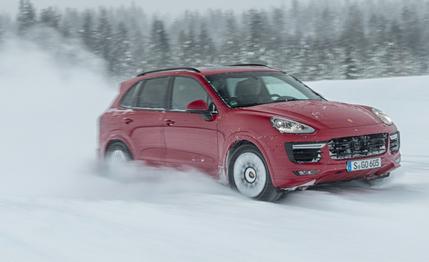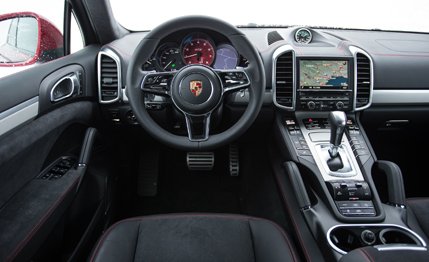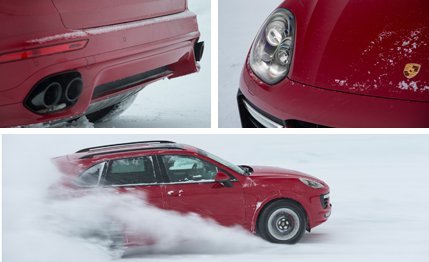 First Drive Review
First Drive Review
We brought the wrong footwear. Warned that our first drive of the 2016 Porsche Cayenne GTS would take place in extreme cold-weather conditions in northern Sweden, we’d packed the same heavy, clunky, thermal-lined work boots that serve so well for walking a dog on bitter winter mornings in Michigan.
Turns out most of the day would be spent at Skellefteå Drive Center, a dedicated facility at a former airbase where we exercised the GTS by ice-dancing through a slalom, drifting on a skidpad, and challenging our car-control skills on a handling circuit. The latter was a slippery tangle of ess bends and hairpin turns on an icy surface through a tunnel of banked snow. The driving mocs we’d left home in the closet might have served better for gently caressing the pedals. But we’d devoted 27 hours to dragging those boots onto three planes and through four airports; damn if we’d leave them in the luggage and endure even a few minutes of cold toes.

Besides, the Cayenne GTS rewards a heavy right foot. The GTS, a Turbo-look version of Porsche’s best-selling model—which slots between the S and the Turbo—has lost two cylinders but gains 20 horsepower in the transition from its former naturally aspirated V-8 powerplant to the new twin-turbo six. This is the same blown 3.6-liter V-6 that powers the revamped Cayenne S, but here it’s tuned to deliver 440 horsepower and 443 lb-ft of torque rather than 420 and 406. It’s strong enough to push two-and-a-half tons of SUV to 60 mph in less than 5.0 seconds, according to Porsche, which cites a 4.8-second time with the optional Sport Chrono package—or 4.9 without it. (The last V-8 GTS we tested needed 5.5 seconds.) The new GTS is also said to lap the Nürburgring in 8 minutes, 13 seconds, just 14 ticks longer than Porsche claims for the mighty, 570-hp Cayenne Turbo S.
Demonstrations of power weren’t in the cards given the low-traction surfaces that prevailed both at the driving center and in the surrounding countryside. We can say that the active exhaust system adds a pleasing musical note to the driving experience and that selecting Sport Plus makes it sing all the way to redline. Losing two cylinders doesn’t seem to have hurt in that respect. Sadly, the GTS has also lost the former option of a manual transmission, although the Tiptronic eight-speed automatic does come with shift paddles behind the 918-inspired steering wheel. Our work boots might have felt like more of a burden had there been a clutch pedal to operate, but that would also have meant more justification for the nearly comic references Porsche made to the legendary 904 GTS racer in explaining the GTS logo emblazoned on the SUV’s lower door panels.
The Cayennes we drove wore the same Pirelli winter tires that dealerships recommend to owners who prioritize performance (they might suggest other tires for customers who think long tread life or fuel economy matter more). They helped to showcase the GTS’s handling prowess despite the severe conditions. Lowered nearly an inch on its standard suspension (the pricey, self-leveling air suspension rides fractionally higher), the GTS still boasts the roll stiffness and steering response that help put the Cayenne at the top of our mid-size luxury SUV/crossover rankings. The previous GTS set benchmark figures with 0.95 g roadholding and 151-foot braking from 70 mph, and nothing during our drive of the new model suggested any loss of ability.

While the icy track exercises were entertaining, they often were conducted with all the electronic assists turned off. Slipping and sliding and challenging your own skills can be fun, but it’s not so informative about what it’d be like to live with a Cayenne GTS. The low winter sun was setting by 3:30 p.m. when we set off on a two-hour back-roads drive that better exhibited just what might entice an adventure-seeking one-percenter to drop $100K on a Porsche SUV. Here, the sure-footed precision of an all-wheel-drive vehicle with all the finely honed electronic assists let us maintain a 60-mph average over a route that the navigation system predicted would take nearly twice as long to complete as it did.
Comfortable and supportive heated seats, an audio system good enough to make us wonder why our hosts had loaded the player with low-bitrate MP3 files, and adaptive headlights that pierced the gloom all contributed to an easy and stress-free drive through the vast, unpopulated region. The array of buttons on the center console made it handy to adjust settings on the fly without taking our eyes from the road—a blessing appreciated all the more upon spotting a pair of giant moose trotting alongside the road, and when a young reindeer came ambling up a village street. Our test example had the optional carbon-ceramic brakes ($8840), which never got properly warmed and felt a little grabby, our only real complaint and one easily avoided by leaving that box unchecked—a move that would also leave plenty of room in the budget for a good set of winter tires. As for our own footwear, we could have done it all in a pair of high-heeled Manolo Blahniks for all the car cared.